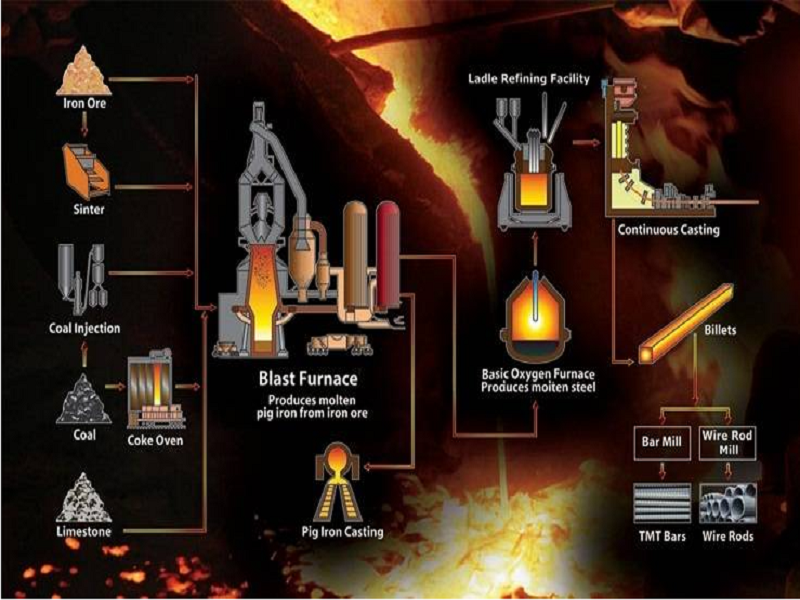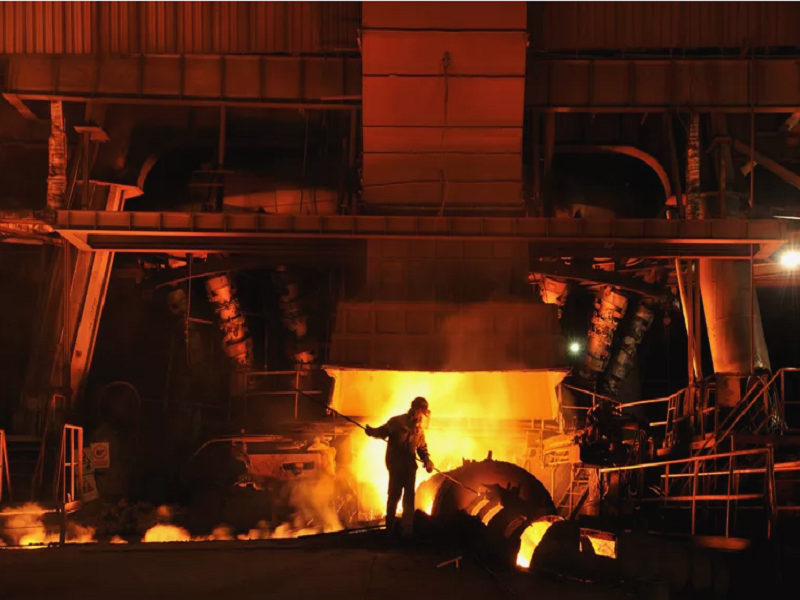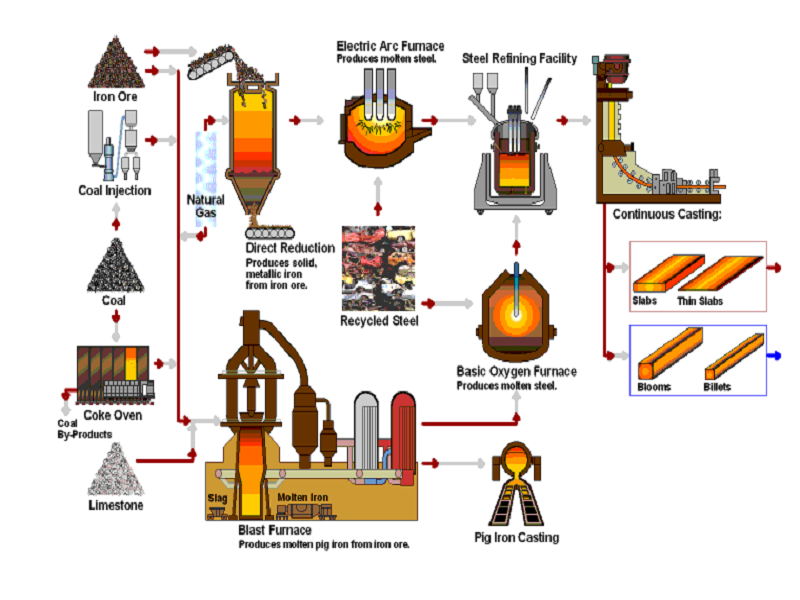

Many of the machines around us are made of steel. However, this does not mean that the metal element iron is used. The various steel materials we see every day are not pure iron of 100% purity, but are smelted with the addition of various alloying elements. The most common type of steel is, of course, carbon steel with a moderate amount of carbon added, usually referred to as steel. Today we will discuss how ‘steel’ and ‘iron’ are made.
Steel production begins with the making of iron. The raw material for steel is iron ore, including hematite (Fe2O3) and magnetite (Fe3O4). Both of these are in the form of iron oxide. Therefore, coke needs to be added as a heat source and reducing agent in the smelting process. Limestone is also added to remove impurities so that all three are burned and smelted in the furnace. It is transformed into pig iron.
This smelting process takes place in a blast furnace. The blast furnace has a steel cylindrical shell lined with refractory materials, such as refractory bricks. Large blast furnaces can reach heights of over 100 metres. The top of the blast furnace is equipped with venting holes and opening and closing devices to exhaust the gases from the furnace and to take environmental measures to prevent the emission of toxic gases.
In addition, there is a raw material input called a hopper in the upper part of the blast furnace and an externally mounted inclined hoist lifts raw materials such as iron ore to the raw material input.
The pig iron smelted in the blast furnace cannot be used directly because it is hard and brittle. It therefore needs to be transported in a subsequent process to the converter for oxygen blowing and melting or sent to the electric furnace to react with scrap steel, which is then made into steel by the steelmaking process.
Once the steelmaking process is complete, the steel flows into the casting pattern to be made into ingots or sent to the continuous casting and rolling process to be rolled into plates or bars. The ingot is a semi-finished product and needs to be reheated before it can be made into a plate or bar. On the other hand, as the continuous casting and rolling process is a manufacturing process that makes efficient use of the waste heat of the material being heated, it is being rapidly promoted from the point of view of increased productivity and energy savings.

Carbon steel is an alloy of iron and carbon. The carbon content of this steel is usually between 0.02% and 2%. Carbon steel usually contains small amounts of elements such as silicon, manganese, phosphorus and sulphur.
The role of each element is as follows: carbon increases the strength and hardness of the metal material, silicon removes oxygen from the steel and manganese removes the element sulphur.
In addition, phosphorus and sulphur are impurities that are present in steel at the lowest possible levels. Therefore, limit values for phosphorus and sulphur content are specified. In addition, carbon steels can be divided into low carbon, medium carbon and high carbon steels depending on their carbon content and into very soft, soft and hard steels depending on their hardness.
The JIS standard specifies the use of different steels and the main terms relating to their quality. Here we describe a few typical types of steel.
The chemical composition of S45C (in %) is presented below for reference.
In addition, heat treatment is an operation in which steel is heated and cooled at the appropriate temperature to improve the mechanical properties of the steel. There are types of heat treatment such as quenching, tempering, annealing and normalising. The use of these heat treatments can improve the hardness, strength and toughness of steel.
Rolled steel for general structural use is commonly used as steel for general structures such as buildings, bridges, ships, railway vehicles and pylons. Steel for general structural use includes steel plates, strips, flats, bars and sections.
These materials are referred to as SS materials according to the English name for structural steel. four types of SS330, SS400, SS490 and SS540 are specified in the JIS standard.
The number 400 in SS400 ensures the lower limit of the material’s tensile strength, which means that the minimum tensile strength of SS400 is not less than 400 N/mm².
Structural materials manufactured into mechanical parts are not only able to withstand static loads but, like gears and shafts, are often used in situations where they are subjected to long-term loads and movements.
Typical materials used for mechanical components are carbon steels for mechanical structures. The number marked between S and C indicates the carbon content. For example, the material S45C means that the carbon content of the metal is 0.45%.
Compared to SS materials, S-C materials specify the chemical composition of the material and are a more reliable material. Secondly, material S-C is a suitable material for finishing and is suitable for machining and heat treatment in manufacturing processes such as forging, cutting and stamping.
To improve the properties of steel, steels containing one or two or more elements in addition to the five principal elements are known as alloyed steels. The main alloying components include chromium, to improve the hardening properties and corrosion resistance of the metal, and molybdenum, vanadium and tungsten, to improve frictional resistance.
Structural alloy steels with higher tensile strength and flexibility compared to stainless steel materials are known as alloy steels for mechanical structures and are classified as strong and high strength steels.
There are chromium steels, chromium-molybdenum steels, nickel-chromium steels, nickel-chromium-molybdenum steels, manganese steels, manganese-chromium steels, etc., whichever steel has improved tensile strength and toughness through heat treatment.
In addition, alloy steels that guarantee hardening properties are known as H steels (Japanese alloy steel grades followed by H), a grade of steel that guarantees an upper, lower or range of hardness of the material at a certain distance from the hardened end. High toughness steels are widely used as materials for the manufacture of parts such as gears, bolts, nuts and axles.

It is mainly used for a wide range of applications such as cold rolled steel sheets for buildings, bridges, ships, vehicles, other structures, pressure vessels or automobiles.High strength steel is an alloyed steel to which nickel, silicon and manganese are added in addition to carbon to increase its tensile strength. Sometimes omitted in English and referred to as High Strength Steel (HTS), ordinary high strength steel has a tensile strength of between 490 and 790 MPa.
Stainless steel is an alloy steel containing either one element of chromium or two elements of chromium and nickel to improve corrosion resistance and hardness.JIS standard specifies the code for stainless steel as SUS (usually SUS is pronounced SARS), such as SUS304 or SUS430, with the number after SUS indicating its brand.
Typically, alloy steels with a chromium content of approximately 10.5% or more can be referred to as stainless steel. A thin oxide film is formed on the surface of the steel by chromium to improve the corrosion resistance of the steel.
The so-called excellent corrosion resistance and resistance to rusting means that the surface of the product does not need to be plated or painted. 13Cr steel with 13% chromium is used for applications where hardness is higher than rust resistance, such as bolts, nuts, knives, forks, cutlery etc. where high hardness is required.
Cast iron is an iron alloy with a carbon content of between 2.14% and 6.67%. Because it has a lower melting point than carbon steel, it is used as a casting material. In general, cast iron has a low elongation, high hardness and high brittleness compared to carbon steel. It is not suitable for use as a structural material, but has advantages in terms of hardness and wear resistance.18Cr-8Ni containing 18% chromium and 8% nickel has not only good corrosion resistance but also good tensile strength. It is used in the manufacture of structural components for automobiles, railways, etc. and is widely used as a construction material.
Grey cast iron is a common cast iron without special alloying elements and is often referred to as cast iron. the JIS standard denotes it as FC and specifies six types of FC100 to FC350.18Cr with 18% chromium is used where high rust resistance is required, such as cooking machinery, automotive parts, chemical equipment, etc.
Here, the number after the symbol FC is the same as for SS materials, which is the minimum guaranteed value for the tensile strength of the material. Compare this value with SS400 and you will see that cast iron has a lower tensile strength.
If you look at a section of grey cast iron with a microscope, you can see the shape of the graphite dispersed in the grey cast iron material. This is also known as scaled graphite cast iron because of the crescent shape of the graphite in the material.
Another way of saying grey cast iron is that it gets its name not only from the grey colour of the cast iron, but also from the graphite that looks like a mouse inside.

Looking at the cusps of crescent-shaped graphite in grey cast iron, we can assume that this is a defect that is responsible for the brittleness of grey cast iron. As a result, it has been improved.
Ductile iron is made by changing the shape of the graphite to a spherical shape so that it can withstand a certain degree of plastic deformation. Ductile iron is recorded as FCD in the JIS standard and seven types of FCD370 to FCD800 are specified. in addition, ductile iron is sometimes referred to as malleable iron.
Ductile iron has a lower vibration absorption capacity than grey cast iron, but is widely used in the manufacture of automotive parts, mechanical equipment parts, steel pipe joints, valves, etc. due to its superior strength and toughness.
In addition, cast iron contains nickel, chromium, manganese, silicon and other elements in alloyed cast iron.

For Further Details,Please Feel Free To Contact Us: